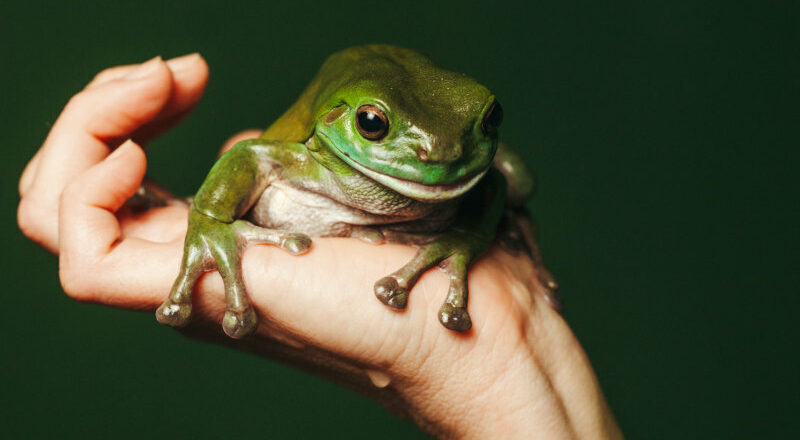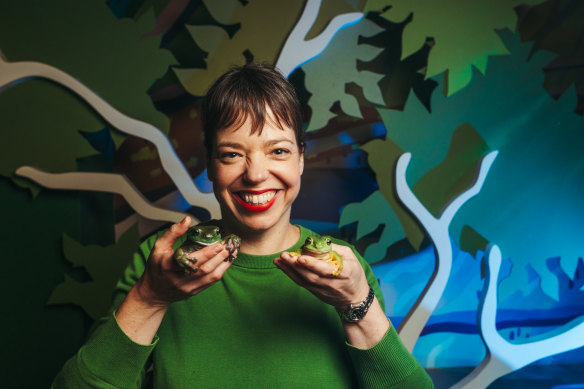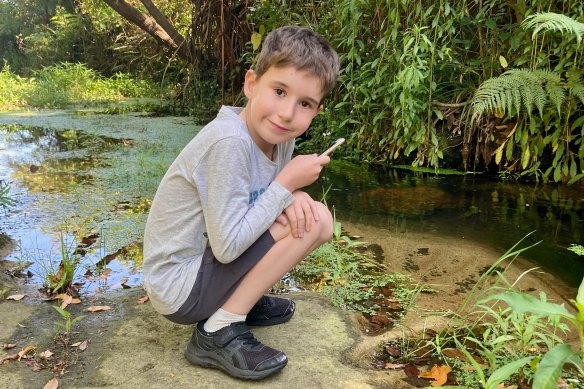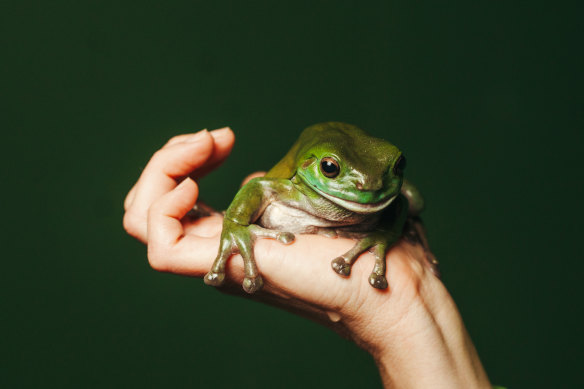This map will help you find out what frog is in your backyard
Save articles for later
Add articles to your saved list and come back to them any time.
They scream, whistle, bleat, growl, whir, quack and emit “bonks”. And on almost a million occasions, when frogs have cast their distinctive calls into the night, Australians have whipped out their phones to listen in.
The FrogID app has become one of the country’s most successful citizen science projects, capturing a database of 965,000 frog calls since 2017 that have generated 20 scientific papers and unveiled five new species.
Dr Jodi Rowley, curator of Amphibian & Reptile Conservation Biology at the Australian Museum, is celebrating almost a million recordings on her ground-breaking app FrogID.Credit: Dion Georgopoulos
“I remember when FrogID was sort of a twinkle in our eye,” said Dr Jodi Rowley, the head of the Australian Museum’s herpetology department and creator of the app. “The [museum’s] director Kim McKay said, ‘We’re going to get a million calls’. I thought there’s no way, that’s insane. But here we are.”
Equipped with FrogID, citizen scientists across Australia record frog calls and beam them back to the museum. Rowley and her team of croak connoisseurs manually identify each one – but they’re working on AI to accelerate the process.
“You get on average two species of frog in one recording, and up to 13,” Rowley said. “That’s where machine learning kind of loses its mind. At this point, humans are still the best for scientific accuracy.”
Just last month, people “recording next to their backyard barbecues” helped identify two new species: the western laughing tree frog in the Northern Territory and, in Victoria, the Otway smooth frog, which is fluorescent orange with “flower-like” yellow splotches.
In Sydney, Rowley discovered that the bleating tree frog – which has a “hideous” call, like a wet, vibrating phone pressed against your eardrum – was actually three species. The city earned a new amphibian resident: the screaming tree frog. Its call is much cuter, like a cartoon alien shrieking in fear.
The striped marsh frog is Sydney’s urban specialist. It loves still backyard ponds and doesn’t need much sunlight, so is perfectly suited for the suburbs. Its call sounds like a racquet striking a tennis ball. Peron’s tree frog and the common eastern froglet are also ubiquitous.
But 80 per cent of frogs can’t survive the city. Many species need clean streams to breed and frogs such as the red-crowned toadlet – which holds out in precious urban pockets – require pristine forest and natural puddles to lay their eggs.
The creatures are excellent bioindicators, and Rowley sees their ebb and flow across the nation as a reflection of how the environment is responding to development and climate change. During 2019’s Black Summer fires, frog recordings plunged by a quarter.
Species such as the green tree frog once spread throughout Sydney but have withdrawn to the Blue Mountains, and 26 species are at risk of extinction Australia-wide.
That’s why, along with the international research she’s sparked, Rowley is most thrilled that FrogID has mobilised an “army” of people willing to help gather species-saving data.
Seven-year-old Henry Lewis is an expert “frogger”, clocking more than 1600 FrogID recordings with his dad Chris.Credit: Chris Lewis
One of those people is Henry Lewis, 7, from Gosford. He and his dad, Chris, became obsessed “froggers” during lockdown. The duo have clocked 1627 recordings and ticked off 29 species with FrogID.
“Henry and my little one, who’s almost four, will be walking down the street somewhere and they’ll just stop and go, ‘Dad. Frog.’ And I won’t even hear it,” Chris said. “They’ve definitely got their ear in.”
Henry has become a multidisciplinary frog-hunting specialist. He’s studied frog biology, learned to read maps to find pockets of habitat, delved into research journals and field guides to track down rare species, and learnt meteorology so he can predict when rain is coming to unleash a chorus of croaks.
A green tree frog in the palm of frog biologist Dr Jodi Rowley.Credit: Dion Georgopoulos
But there’s never enough data – despite the upcoming FrogID milestone, only a third of the country has been surveyed for calls, and biologists need more froggers across Sydney and beyond.
Rowley has identified the stretch of land from Sydney to the South Coast as a priority for eager eavesdroppers, in the hopes they’ll hear a subspecies of giant burrowing frog that’s gone quiet.
As FrogID week commences, NSW Arts Minister John Graham described the app’s 965,000 recordings as staggering, and urged citizen scientists to join the cause and bring the database to 1 million calls.
“FrogID shows Australians at their best,” he said. “This program is providing the Australian Museum with invaluable local data to understand where and how our frogs are surviving, thriving and in need of help.”
The Examine newsletter explains and analyses science with a rigorous focus on the evidence. Sign up to get it each week.
Most Viewed in National
From our partners
Source: Read Full Article




